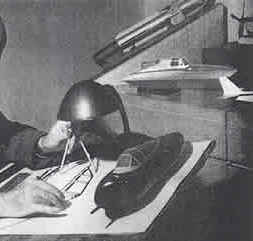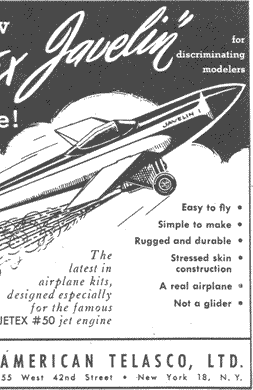|
|
|
|||
|
|
||||
|
|
||||
| ARCHIVE: Jetex Paper Models | ||||
|
|
HOME | SITE MAP | FORUM | CONTACT |
|
||
|
ABOUT | MOTORS | MODELS | ARCHIVE | HISTORY | STORE | FAQ | LINKS
|
|
|
|
|||
|
Making Cut-out Models for Jetex Power by Wallis Rigby
Abridged from an article in Publisher's Weekly, 4 August 1951 Wallis Rigby, the doyen of paper model designers, tells of his rise to his position of pre-eminence and discusses how he came to use Jetex engines as a source of motive power. |
||||
Thus I was launched, and thereafter – up to 1935 – I designed single models for five-and-ten sales or for give-away premium use by Amalgamated Press and other publishers of "boys' papers." Then the Daily Mail ordered and used my first Giant Model Book as part of its premium promotion and the Mail and Daily Express used successive model books. In 1937 Whitman reprinted one of the Rigby books, and in 1939 the New York Daily Mirror used a special edition. The Mirror book resulted in a year's contract with King Features, under which a weekly model, "Modem Models by Rigby," appeared in the Comic Weekly. This was not too great a success, as one could not honestly expect kids to glue down newsprint onto suitable building paper. It was during World War II that Garden City and McKay accounted for the bulk of the million and a half copies or more of my model books that have been sold. Titles included the McKay "Book of Models" (15 models at $1) and "Book of Scale Models and Working Models"; and the Garden City "Easy to Build Models of War Planes of the World" (16 models including 10 that would fly at $1.39), and "Easy to Build Models of Naval Craft" (24 models at $1). After the war, Nabisco issued in Shredded Wheat packages a set of 36 card models of famous airplanes, the total number of cards running into the millions. At present, "Rigby's Flying Models of Jet and Rocket Planes" (Garden City), "The 7-Foot Model Train Book" (Grosset) and "The Book of Model Fire Engines" (Grosset) are selling excellently. There are to be new books soon. Last year, as an experiment, the rocket book was put on television on a local New York 15-minute Sunday morning program in April over WNBT. Up to that point, this book had been selling reasonably well. What happened? Well, for the first time in the history of these books a vast audience could see what the models would actually "do." Someone had mislaid a film which was to constitute a five-minute portion of the show. Fortunately I had been playing with the set of ten flying rockets with a small boy connected with another act, and I dragged this boy into the show. We ad-libbed, all the planes flew, the boy's spontaneity was excellent, and Garden City got a sale of 5,000 copies at $1 each. But that was a rainy Sunday. The next Sunday was the first fine day of the spring, all our customers were out of doors, and sales dropped, week after week. Later a coast-to-coast Howdy-Doody spot produced sales of 7,343 copies, with the aid of commercial announcements and excellent flying of the models by Claribel the Clown. |

-
Publisher's Weekly, 4 Aug. 1951
|
|||
I have never used paper or card as a substitute for other materials. For my type of modeling, I have stuck to the use of tough card or paper (paper being always best for power driven model planes) because there is no other material so suitable for the ratio of ruggedness to simplicity in assembling which this class of detailed modeling demands. I have rigorously kept the models in materials and sizes with which the kids can build and, if the models have performance value, with which they can play. Some of the cereal pack models have been excellent, some have been frustrating to young people,. and most have had to be cut from thick, brittle board: this leads to disappointment, a tendency to shy away from this valuable form of fingercraft, and a parental reaction against the medium which has disappointed the child. A word on accessories, fasteners and sources of power: These, so far, have not been included in my model books (though they have been provided in model kits). Instructions in the books simply tell the assembler to use some easily obtained item such as a round or a flat toothpick for a gun turret, an axle, a mast; paper clips for fasteners, and buffers in the jet plane book; a little glue to strengthen the joints and lengthen the life of the model. Most fastenings are simply a matter of inserting a tab into a slot; and often the tab becomes part of the design. In the fire engine book there is an extension ladder than can be raised and pivoted on a universal joint. Yes, the universal joint is part of the cardboard cut-out, and no other parts are needed at all. |

-
Air Trails, April 1951
Wallis Rigby's 'Jetex Javelin'. The tail of a completed Javelin can be seen on the right in the photo
above, of Rigby in his studio. Note the clever use of the term "stressed skin" to describe Rigby's
construction. By folding, bending paper and card, the model's skin is stressed and thus the components
gain a strength that give the model its claimed "rugged and durable" characteristics. |
|||
In the course of my experiments I have developed my art to a point where, today, I am building and running – almost entirely from good cards – boats and planes which actually run on jet-fuel engines! The furor these card-built jet planes cause when I am running them at a park or some lake has to be seen to be believed. The cry, "It's only cardboard!" is followed by an urgent demand for information as to where to buy them. These models are not in books, but some have been made up in kits, for example the Jetex Javelin Kit, sold by me and the American branch of Telasco, a British firm, which makes the little jet engine. The jet mechanism is entirely safe, by the way. The engines in my jet plane and jet boat models are so constructed that no flame can injure the model or the user. You can read more about Wallis Rigby and download examples of his models on the Rigby Paper Model Club website. |

-
Publisher's Weekly, 4 Aug. 1951
|
|||
|
|
|
|||
|
|
|
|
|
|
|
|
Acknowledgements - Article, photographs and further investigative work by Mike Province - Telasco advertisement from MAAC Archives via Bill Henderson |
|
|
|
|
ABOUT | MOTORS | MODELS | ARCHIVE | HISTORY | STORE | FAQ | LINKS |
|
|
Terms of Use
|
Queries? Corrections? Additions?
Please
contact us.
|
|